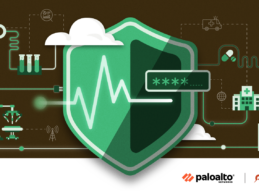What You Should Know:
What You Should Know:
- Palo Alto Networks (NASDAQ: PANW) announced Medical IoT Security — the most comprehensive Zero Trust security solution for medical devices — enabling healthcare organizations to quickly and securely deploy and manage new connected technologies. Zero Trust is a strategic approach to cybersecurity that secures an organization by eliminating implicit trust by continuously verifying every user and device.
- As healthcare providers use digital
Read More
Connected Medical Devices
HLTH22: Henry Schein Medical Expands SolutionsHub with Rimidi
What You Should Know:
- Henry Schein Medical today announced the expansion of its Solutions Hub with Rimidi, a SaaS company that brings together remote patient monitoring, patient-reported outcomes, and clinical decision support to help enhance patient care.
- With this partnership, clinics, medical groups, and health systems served by Henry Schein will have access to Rimidi’s cloud-based software platform, which helps deliver an efficient model of care for patients with chronic
Read More
IoMT Is Improving Patient Access: We Must Avoid Creating New Barriers
The Internet of Medical Things (IoMT) is changing the face of healthcare and has the potential to significantly improve patient access as well as system efficiencies. The adoption of telemedicine, for example, spurred on by the Covid-19 pandemic, has spread rapidly. Forrester revised its forecasts to predict that virtual care visits in the United States will soar to more than one billion this year—including 900 million visits related to Covid-19 specifically. Likewise, in the United Kingdom,
Read More
Philips Launches Integrated Cybersecurity Services to Protect Connected Medical Devices
What You Should Know:
- Philips partners with CyberMDX, a leader in
connected medical device security, to provide vendor-neutral solutions to
protect connected medical systems and devices.
Philips, today
announced the introduction of the Philips Cybersecurity
Services for seamlessly integrating and enhancing strategic security solutions
for Philips customers. The Philips Cybersecurity
Services comprise an end-to-end suite of technologies and services to
Read More
Israeli Digital Health Startup G Medical Innovations Withdraws $30M US IPO
What You Should Know:
- Israeli-based G Medical Innovation has withdrawn its plans for an initial public offering (IPO) on Tuesday, Nasdaq first reports.
- The company originally filed
an IPO to raise $30 million by offering 5 million shares at a price range of $5
to $7 last month to list on the Nasdaq under the symbol GMVD.
- The recent withdrawal marks the company's second
attempt to go public in the US, previously filing in May 2019 and withdrawing
the following August. The company
Read More
Social Distancing for Medical Devices: 5 Steps to Clinical Network Segmentation to Thwart Cyber-Attacks
Since the beginning of 2020, cyber-attacks have spiked by 300%. As members of the world's most targeted industry, healthcare organizations like hospitals, clinics, pharmacies, and distributors of medical equipment are more at risk now than ever.
Even if an attack isn't directly targeted at connected medical (or, Internet of Medical Things: IoMT) devices, it can spread through a hospital’s internal network and infect equipment used to diagnose and treat patients such as IV pumps, patient
Read More
FCC’s COVID-19 Telehealth Programs Surpasses $50M in Funding
What You Should Know:
- To date, the FCC’s COVID-19 Telehealth Program, which was authorized by the CARES Act, has approved funding for 132 healthcare providers across 33 states plus Washington, DC for a total of just over $50M in funding.
The Federal Communications
Commission’s Wireline Competition Bureau today approved an additional 43
funding applications for the COVID-19 Telehealth
Program. The seventh set of healthcare providers in both urban and
rural areas of the
Read More
Why Now’s the Time to Use Connected Health Devices for Diabetes Prevention
It’s no secret that chronic disease remains the leading cause of death worldwide, taking up 90 percent of healthcare spending in the United States. For the last several years, there has been a rise in discussions and research around the promise of connected health devices helping manage and prevent chronic conditions as well as healthcare spending. However, today a number of factors are coming together to make that promise a reality. This includes the improvement of real-world data insights
Read More
GE Healthcare Unveils Medical Device Cybersecurity Offering for Hospitals
- GE Healthcare introduced a new medical device cybersecurity service to help hospital groups fight against cybersecurity risks.
- The offering, entitled Skeye, blends industry expertise, AI and process management tools to augment hospitals’ existing resources and capabilities by providing proactive monitoring through a remote security operations center – helping them detect, analyze and respond to cybersecurity threats and events in real-time.
GE Healthcare has introduced a new
Read More
3 Healthcare Cybersecurity Trends to Watch in 2020
The healthcare industry frequently struggles with data breaches and other cybersecurity incidents. That's likely because cybercriminals know the value of medical data. It's also problematic that healthcare information often gets passed between multiple parties and organizations, some of which may have insufficient security practices.
Attacks from malicious actors aren't ceasing, which means healthcare cybersecurity must remain a priority in 2020. But, what, specifically, should parties
Read More










